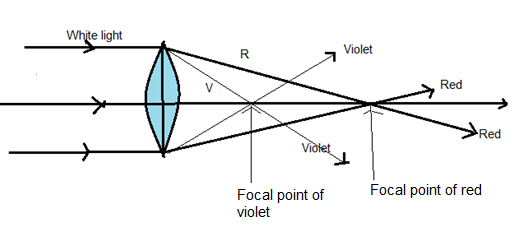
The main reason for axial chromatic aberration in the formation of images by lens is/are:
A. focal length of lens is different for different colours.
B. the material used to make the lens is not uniform
C. different sections of the lens are of different thickness.
D. all of the above
Answer
478.8k+ views
Hint
We know that focal length depends upon the wavelength. We will write what chromatic aberration is. We can easily get to know from the figure that lights of different colour have different focal lengths.
Complete step by step answer
It is to be noted that no lens can converge the rays of all colours in a single point. For this reason, no image formed by the lens becomes distinct; that is, during the formation of image there remains some error all the time. The error is called chromatic aberration.
We know that the focal length of a lens depends on the colour of the light. Focal length for violet light is least and that for red light is greatest. Light of other colours have intermediate values of focal length. Hence a kind of dispersion occurs.

The lens is unable to bring all the wavelengths to colour to the same focal plane or when wavelengths of colour are focused at different positions in the focal plane. The aberration is caused by lens dispersion, with different colours of light travelling at different speeds while passing through a lens.
As a result, coloured images of an object are formed at different distances, when an object is illuminated with white light. Their sizes are also different. The image can look blurred or noticeable coloured edges can appear around objects especially in high contrast situations. This is called chromatic aberration.
Hence the required solution is chromatic aberration occurs because focal length of lens is different for different colours (Option- A).
Additional Information
Chromatic aberration can be minimised by combining two or more properly chosen lenses axially, so that chromatic aberrations of all the components are added up to zero or nearly zero. Such a combination of lenses is called chromatic doublet.
Note:
Chromatic aberration occurs because the focal length of different colours is different. It doesn’t depend on the material used in the lens or if there exists different thickness in the lens. A lens may be assumed to be made of a number of prisms placed one above another. Just a prism disperses white light lens also disperses white light. So, options “B” and “C” will not be correct.
We know that focal length depends upon the wavelength. We will write what chromatic aberration is. We can easily get to know from the figure that lights of different colour have different focal lengths.
Complete step by step answer
It is to be noted that no lens can converge the rays of all colours in a single point. For this reason, no image formed by the lens becomes distinct; that is, during the formation of image there remains some error all the time. The error is called chromatic aberration.
We know that the focal length of a lens depends on the colour of the light. Focal length for violet light is least and that for red light is greatest. Light of other colours have intermediate values of focal length. Hence a kind of dispersion occurs.

The lens is unable to bring all the wavelengths to colour to the same focal plane or when wavelengths of colour are focused at different positions in the focal plane. The aberration is caused by lens dispersion, with different colours of light travelling at different speeds while passing through a lens.
As a result, coloured images of an object are formed at different distances, when an object is illuminated with white light. Their sizes are also different. The image can look blurred or noticeable coloured edges can appear around objects especially in high contrast situations. This is called chromatic aberration.
Hence the required solution is chromatic aberration occurs because focal length of lens is different for different colours (Option- A).
Additional Information
Chromatic aberration can be minimised by combining two or more properly chosen lenses axially, so that chromatic aberrations of all the components are added up to zero or nearly zero. Such a combination of lenses is called chromatic doublet.
Note:
Chromatic aberration occurs because the focal length of different colours is different. It doesn’t depend on the material used in the lens or if there exists different thickness in the lens. A lens may be assumed to be made of a number of prisms placed one above another. Just a prism disperses white light lens also disperses white light. So, options “B” and “C” will not be correct.
Recently Updated Pages
Class 10 Question and Answer - Your Ultimate Solutions Guide

Master Class 10 Science: Engaging Questions & Answers for Success

Master Class 10 Maths: Engaging Questions & Answers for Success

Master Class 9 General Knowledge: Engaging Questions & Answers for Success

Master Class 10 General Knowledge: Engaging Questions & Answers for Success

Master Class 9 English: Engaging Questions & Answers for Success

Trending doubts
The gas that burns in oxygen with a green flame is class 12 chemistry CBSE

The probability that a leap year will have only 52 class 12 maths CBSE

Describe the poetic devices used in the poem Aunt Jennifers class 12 english CBSE

And such too is the grandeur of the dooms We have imagined class 12 english CBSE

What does the god that failed refer to class 12 english CBSE

Which country did Danny Casey play for class 12 english CBSE




